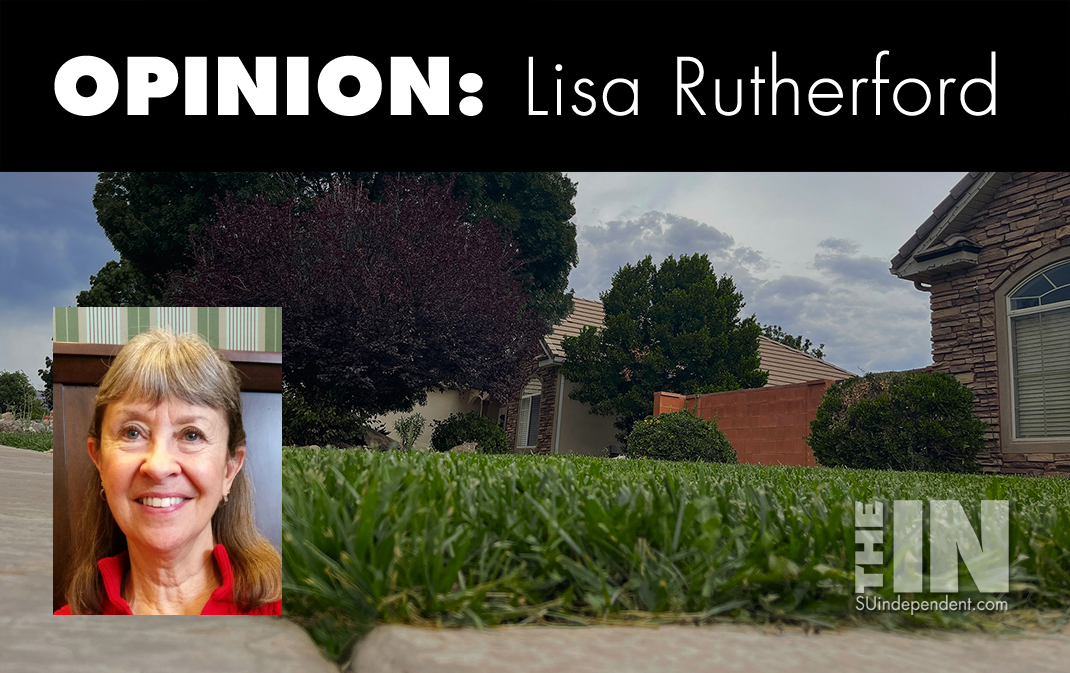
Ditching Lawns Is Completely Doable And Necessary
– By Lisa Rutherford –
I have been studying and writing about water issues in Washington County for over ten years, even when we were not in the dire situation we are now. My concerns about water have worsened as the drought continued — now in its twenty-first year. But it’s only now that I see people really becoming aware of the need to conserve water.
During this time of continuing and worsening drought people are learning that “yellow is mellow while brown goes down” when it comes to toilets, shorter or more infrequent showers will suffice, and yellow or tan is the new green when it comes to lawns. Others, however, continue to waste, and as one of my neighbors did, some even tear out desert landscaping to install vast amounts of lawn around their home. There will always be those who see others wasting and justify that they can, too — using the rationale, “If I don’t use it, someone else will.” But is that what our water future really deserves?
As we work to evolve our water ethos we are being confronted by Utah’s “growth ethos.” While some towns in Utah are actually putting a moratorium on growth while they work to figure out the water situation that confronts them, our area continues to issue permits as if there is no problem. In my town of Ivins, building permits were higher in 2020 than in 2019, are on track to be higher in 2021 than in 2020, and lawns are still seen in new developments. There will surely be a reckoning if this situation is not resolved.
However, even the Deseret News wrote that lawn is becoming a new four-letter word in Utah and that Governor Cox is actually considering following in Nevada’s footsteps when it comes to disallowing “non-functional” grass. Some water articles have mentioned using grasses such as Bermuda or fescue to save water, but these still need water and require maintenance including the addition of chemicals.
Another matter to consider is the nexus between water and food. Food has been grown in Southern Utah ever since pioneers arrived and set up their homes. But having lawns and food may require more water than our area can support. Even in Salt Lake City, an area that gets more water than we do, many people have removed their lawns and replaced them with garden boxes.
There are citizens who want to be part of the solution. Many just don’t really know how to start and it can seem daunting. We removed our front lawn in 2013 and this year we removed the last of our lawn in the backyard and extended our patio. Now we have a much larger and more useful patio. We do not miss the lawn. The patio was not cheap but there are ways to get rid of lawn that can be less expensive and ease one into the process by taking “baby steps.”
Since removing grass can be a daunting task if done all at once, removing some small areas first and replacing with appropriate drought-tolerant plants can get you started. But even this can be challenging if a sprinkler system is involved. And a trip to the nursery to gain knowledge about what plants to use doesn’t completely solve the problem of transitioning either. Perhaps what’s needed is an entity that can help people through this process at a reasonable or low cost. Perhaps a non-profit can get some funding to take on this needed effort. Until then there are sites that can help such as https://www.doityourself.com/stry/xeriscapes and https://www.sierra.com/blog/article/how-to-xeriscape-your-yard-this-spring/.
The best part of replacing lawn with xeriscaping is less maintenance, less watering, no mowing and edging, fewer problems with pests and disease, and less fertilizer – helping you and the environment — leaving more time for other interests. Don’t count on the unnecessary, risky and expensive Lake Powell Pipeline to solve our water issues. Let’s move into a new water future in Washington County – make the area bloom with drought-tolerant plants.
Viewpoints and perspectives expressed throughout The Independent are those of the individual contributors. They do not necessarily reflect those held by the staff of The Independent or our advertising sponsors. Your comments, rebuttals, and contributions are welcome in accordance with our Terms of Service. Please be respectful and abide by our Community Rules. If you have privacy concerns you can view our Privacy Policy here. Thank you!
Click here to submit an article, guest opinion piece, or a Letter to the Editor





Wonderful and timely article given our 21-year drought. While encouraging water conservation is admirable, real results will only be achieved with water rates that motivate real, widespread action. Unless our water rate-setting officials embrace conservation with rates that climb steeply with each additional 1000 gallons of usage per month — as they do in almost all southwestern U.S. cities — all well-intentioned talk will fall on too many deaf ears.
Exactly right, Howard! So glad you added this point. Unless our water rates accurately reflect the value of this precious resource many people will continue to waste it. Our rates should include a base amount that’s reasonable but should go up steeply after that. Of course, there will be those with money who feel they can afford to continue to waste in spite of the cost. Hence the need for regulations that restrict having too much lawn. Some should not be allowed to waste at the expense of others. Doing your own thing is appropriate with regard to some matters, but not when it comes to an essential element such as water. In our small town of Ivins there’s talk of requiring developers to include a disclaimer to their buyers about the fact that water may not be available to serve their property. That should be a real eye opener.